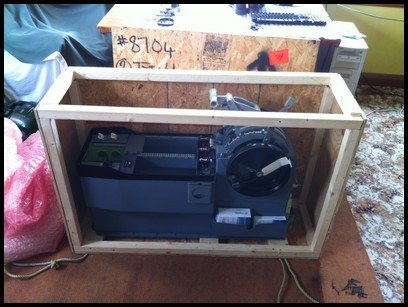B737-300 Throttle Quadrant & Center Pedestal - Arrived at Last
/
A big orange truck from TNT Express parked outside the house this afternoon and the driver began to offload a large wooden crate that weighed around 80 kilograms. I could be only one thing – the Boeing throttle quadrant and avionics box (center pedistal) had finally arrived.
Together, the driver and I manhandled the crate through the hallway of the house to the room in which construction of the simulator is taking place. Removing a heavy piece of machinery from a wooden crate can be tricky, and the only method was to disassemble the box screw by screw – WOW what beauty!
Initial Thoughts
The throttle and avionics bay is a genuine aircraft part so there wasn’t much to not like; you can’t “immerse” yourself or get a more authentic experience than by using a real aircraft part. The throttle originally was in use in a Boeing 737-300 with South West livery. Unfortunately, the guy at the tear down yard didn’t document the tail number of the aircraft it was removed from. It would have been nice to have a photo of the actual aircraft to place on the Blog.

The first aspect I noticed about the throttle was the build. It’s a solid piece of engineering built to withstand the neglect of pilot use and now simulator use. I don’t believe the throttle will ever be damaged from neglect my end – its’ solidly constructed. The feel when you push the two power levers forward is - well – you just have to be here! Manoeuvring the flap lever through the various indents is equally rewarding. Knowing that the throttle was once used in a real aircraft by real pilots adds a completely new dimension to flight simulation.

Retrofitting and Connectivity
During the refurbishment of the throttle, I had decided to not bastardize the throttle to try and replicate the appearance a throttle from a Boeing NG. Therefore, the throttle remains a 300 series throttle. It has been repainted only where necessary and decals have been replaced only when they were unreadable. The internal mechanism of the throttle has been completely striped, cleaned and serviced. Parts, such as the huge cog wheels and unnecessary internal wiring have been discarded as these are not required for simulation use.
To allow the throttle to connect correctly with flight simulator, three Phidget cards (0066 & 0064) & a Leo Bodnar card (BUO 836X) have been used. The cards are connected directly to the front of the throttle casing and will not be visible once the throttle casing is connected to the centre stage of the main instrument panel (MIP).
All the functions of the throttle operate with the exception of the stab trim switches, which can be linked to another FS function if required. Trim wheels are functional with the use of a servo motor and the trim spins when electric trim is activated on the yoke. Back lighting is integrated back lighting (IBL) using genuine Boeing 5 volt bulbs.
oem 737-300 throttle quadrant - initial thoughts: it’s built like a thunderbox
Current Status
At the moment I’ve only taken delivery and am in the process of connecting a Benchmark card to an external power source to allow power to reach the 5 volt lighting bulbs and servo motors. I have little doubt that there will be teething issues with software as I configure everything for correct functionality, but I believe that this extra effort is worthwhile to be able to use a real throttle instead of a replica.
Center Pedestal
The avionics bay is a two-bay type. Two-bay types were mainly used on the earlier Boeing classic series jets up to the 200 series, however, a number of 300 series aircraft used them as well as 400 series. The bay was attached to the throttle when I bought it, so rather than dump it and replicate a NG three-bay; I’ve decided to use it to maintain authenticity. I may at some stage in the future replace it with three-bay – I’ll see how things develop once I begin to populate the bay with avionics instruments. One benefit of using a two-bay style is that once Weber seats are fitted to the flight deck there will be more room to squeeze past to get into the seat!
An interesting feature to the unit is the positioning of two oddly shaped aluminium pull downs. At first, I had no idea what these were used for. Then it dawned on me – they are retractable coffee cup holders. What more can you ask for (laughing).
oem 737-300 fire suppression panel
Fire Suppression Panel (FSP)
The fire suppression module was an afterthought. A second hand unit was available and I decided to retrofit this with limited functionality to flight simulator. At the moment IBL works, and when pulled, each fire handle does what it’s supposed to do. At some stage in the future I may activate the fire bell. But, at the moment it’s early days with regard to this. Basically it’s a module that has to be installed into the avionics bay for aesthetics; a TQ without a fire suppression module looks a slightly naked.
More on the actual avionics bay at a later stage when I begin to populate the bay with instruments - much kmore interesting than looking at "naked bay"
Additional pictures - 737-300 Throttle Quadrant gallery.











































